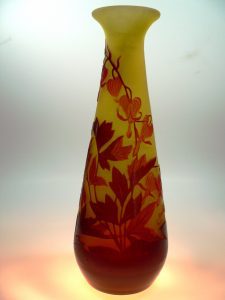Art Nouveau Vase - German/German

At the turn of the 19th and 20th centuries, we encounter Art Nouveau in art. Art Nouveau glass rejects the imitation of historical styles and becomes the artistic antithesis of glass manufactories. One of the most important protagonists of European Art Nouveau glass art was the craftsman, botanist, chemist and manufacturer Emile Gallé, who lived in Nancy in France. The yellow vase with the reddish-brown plant decoration "Teary Hearts" was created by him.
Gallé found his motifs in nature. He advocated respect for nature because he saw it endangered by industrialisation. But the Orient and literature were also important sources of inspiration for him. Gallé was highly experimental when it came to glass refinement and glass production - even though he never worked at the glass furnace himself. He first had his designs transferred to the glass as enamel paintings and glass cuts. Later he moved on to etching, enamelling and appliqué. The vase in the glass museum was made by Gallé around 1900 using the etching technique.
The vase was a gift from the donor and collector of Art Nouveau glass, Henri Veill from Clermont-Ferrand, France, whose sister lives in Wertheim. The donation was a great stroke of luck, because a short time later a flat fire destroyed Veill's entire collection.
Art Nouveau Vase - English

At the turn of the 19th and 20th centuries we come across Jugendstil, or Art Nouveau. Glass made in this style rejected the imitation of historical styles and became the artistic antithesis of glass manufacturers. One of the most important protagonists of European art nouveau-style glass art was a craftsman, botanist, chemist and factory owner who lived in Nancy in France: Emile Gallé. And he made the yellow vase with red-brown plant decoration entitled "Bleeding Heart.
Gallé found his motifs in nature and he stuck his neck out for them because he could see they were endangered by industrialisation. But the Orient and literature were all such important sources of inspiration for him and Gallé was more than happy to try out new things in glass production and finishing - even though he never worked at the glass furnace himself! To begin with his designs were applied to the glass using enamel or cut glass, but he later turned to etching, melting and appliqué. Gallé produced the glass in front of you in around 1900 using the etching technique.
This vase was a gift from the sponsor and collector of Art Nouveau glass, Henri Veill from Clermont-Ferrand in France, whose sister lives here in Wertheim. And the donation of it turned out to be a stroke of luck, because shortly afterwards Veill's collection was completely destroyed in a house fire.